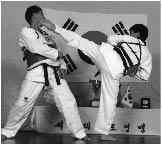Complete Kicking (24 page)
Authors: Turtle Press

SPORT APPLICATIONS
Moving faster than your opponent is the key to scoring with turn kick. To do so, you should try to perceive your opponent’s intent to attack. Look for cues such as blinking, a sharp inhalation, lowering of the shoulder, movement the front foot, twitching the hip, etc. The above photo demonstrates a well timed turn kick, striking when the opponent’s rear leg axe kick is at maximum height and his torso is vulnerable to a counterattack.
Before the opponent completes his high roundhouse kick, counter with a quick turn kick.
When an opponent hesitates, attack with a turn kick.
Counter with a retreating turn kick as soon as your opponent lands after kicking.
common mistakes
MISTAKE 1: Leaning the torso or head to the side.
SOLUTION: Avoid jerking your head when turning. Rotate your head and torso around the vertical axis that connects the top of your head and the center of the spine. Keep your head height level.
MISTAKE 2: Turning too widely or stepping in a zigzag pattern.
SOLUTION: If your turn is not made on a single line directly toward the target, you will find yourself out of position to hit the target. Rotate your hip first, spot the target over your shoulder and then turn so you have the target in sight at all times. Move on a straight line with your torso erect.
• remember
1. Rotate your hip first and let the other parts of the body follow.
2. Keep your head straight and rotate it smoothly to spot the target.
3. Relax your shoulders and allow your center of the gravity to guide you.
• avoid
1. Leaning the torso or head off the target line (
2. Jerky turning of the torso or head
3. Large turning motion
4. Zig zag stepping, stepping off the force line, poor distance control
5. Banging knees with the opponent
SPIN WHIP KICK
purpose
Spin whip kick is used to counterattack against roundhouse kick or axe kick. It can also be a powerful deceptive knockout attack. The knockout power of spin whip kick comes from the turning momentum of the body. It is stunning and devastating in effectiveness because it has the greatest range of motion of any kick.
key points
Timing and distance are the primary factors for a successful spin whip kick. Power is secondary because without proper timing and distance, a powerful spin whip kick is risky and useless.
striking area
Ball, heel, bottom of the foot
targets
1. temple
2. jaw
3. face
4. neck
how to
1. From fighting stance, shift your weight to the neutral position.
2. Rotate your body to the rear, chamber the rear leg and look over your shoulder.
3. Raise your kicking leg and keep your body as compact as possible before kicking.
4. Shoot your foot toward the target, about 6-12 inches in front of it, then hook across and through the target. Continue the spin and the trajectory of the kicking leg, returning to fighting stance.
Spin whip kick follows a fan shaped path, lashing the target as if with a whip. The power of this kick comes from a combination of the large range of motion of the foot and the central axis of the torso, around which the foot moves. The torso functions as a stabilizer and your standing foot acts as the pivot.
Diagonal sit-ups build the muscles of the torso used in spin whip kick. As your muscles become stronger, try a larger range of motion during the sit-up, which will increase the range of motion of your kick.
Other books
Hermoso Caos by Kami García, Margaret Stohl
The Pleasures of Autumn by Hunter, Evie
In the Fold by Rachel Cusk
Maureen McKade by A Dime Novel Hero
The Wraiths of War by Mark Morris
The Legacy of Copper Creek by R.C. Ryan
The Wedding Tree by Robin Wells
Agent 21: The Wire by Chris Ryan
A Cadence Creek Christmas (Cadence Creek Cowboys) by Alward, Donna
The Morrow Secrets by McNally, Susan









